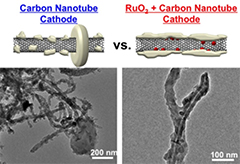Sep. 19, 2013
Ruthenium oxide nanoparticles improve lithium-oxygen battery efficiency

Dr. Byon and Dr. Yilmaz from the RIKEN Byon Initiative Research Unit with colleagues from the Synchrotron Radiation (SR) center in Ritsumeikan University report that using ruthenium oxide nanoparticles (RuO2 NPs) on carbon nanotubes as cathode can improve the electrical efficiency of lithium-oxygen (Li-O2) batteries by 73%.
The low electrical efficiency of the Li-O2 electrochemical reaction is one of the most significant challenges for the development of efficient nonaqueous Li-O2 batteries. It arises from the difficulty in decomposing the discharge product Li2O2, which has an insulating effect, during charge.
The researchers show that RuO2 NPs transform Li2O2 into a poorly crystalline, shapeless layer covering the carbon nanotubes. This differs greatly from the toroidal and polyctystalline Li2O2 generated by a carbon nanotube-only cathode after discharge.
This unique structure of Li2O2 provides a larger contact area with the conducting carbon nanotube cathode as well as a higher conductivity and thus requires less energy to be decomposed during charge.
The study is published in the journal Nano Letters, DOI: 10.1021/nl4020952
